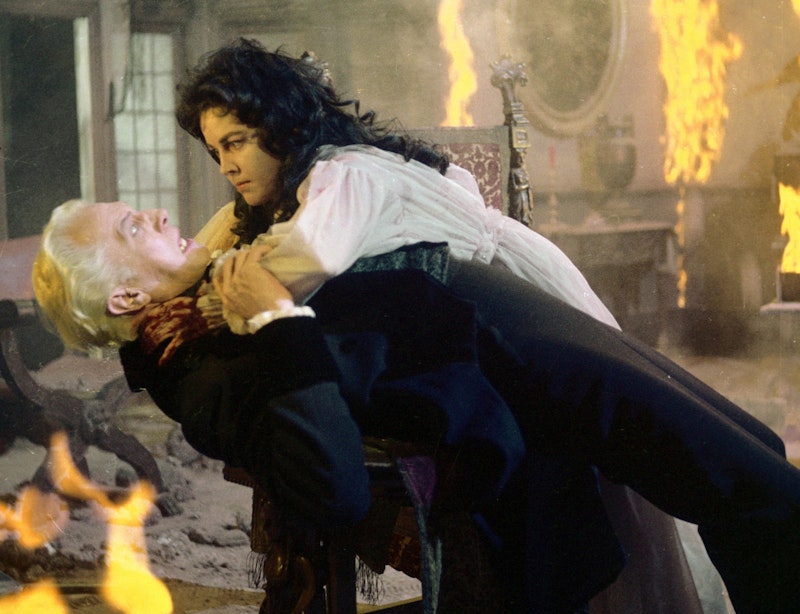The 1950s saw independent film studios and producers sprout across the United States. American International Pictures was one of those studios, specializing in black-and-white quickies to fill double-bills in drive-in theaters, and Roger Corman was one of those producers. Canny and self-motivated, Corman was also a director, and by 1960 had become one of AIP’s main filmmakers.
Corman had a finger on the pulse of the film market, and knew the audience for black-and-white movies was declining. So when AIP asked him to shoot a couple of horror films, he suggested instead doing one film in color, and pitched an adaptation of Edgar Allan Poe’s short story “The Fall of the House of Usher.” AIP agreed, and gave Corman 15 days to shoot. For Corman, that was a lot.
To write the adaptation Corman got horror novelist and screenwriter Richard Matheson, then one of the main writers of TV’s The Twilight Zone. Vincent Price, a known star who’d recently moved into lower-budget horror films, came aboard as the lead. And the result was a solid piece of work that turned a significant profit for AIP and led to a series of seven further Poe adaptations by Corman, often in collaboration with Matheson and Price.
House of Usher still holds up. It’s distant from its source material, but that’s because it does interesting things with Poe’s text. It’s shot on a budget, but shot by a man who knows how to tell a story in pictures, and make a low-budget movie. Corman used budgetary limitations as inspiration, and House of Usher works not despite its budget but because of the specific feel Corman gets out of what’s available to him.
The film begins with a rider making his way through a burned and blasted forest. It’s not unlike the opening to Poe’s tale, and it’s the start of Corman’s budget-conscious inventiveness—he shot it in the Hollywood hills after a fire created a landscape he could use. When the rider comes to a large house, we find out he’s Philip Winthrop (Mark Damon), the fiancé of Madeline Usher (Myrna Fahey), and has come to see Madeline in her family home. But Madeline’s brother Roderick (Price), who also lives in the house, opposes their marriage, ashamed of the cruel monsters in the Usher bloodline and determined to prevent any further Usher offspring.
This creates a taut dramatic situation. Usher family secrets come out. Madeline dies, but Philip learns that death-like faints run in the Usher family. And so a climax not too dissimilar to Poe’s is set up, in which the house of Usher falls in dramatic fashion.
It’s a very different story from Poe’s, but it’s hard to see how it could be otherwise. Much of the prose tale is the (unnamed) narrator reflecting on his friend Roderick Usher and on the atmosphere of the house. It avoids drama in favor of the slow build of an increasingly gloomy atmosphere that finally breaks out in a scene of horror. Matheson and Corman find a narrative structure that captures much of what’s important in the story, while replacing brooding melancholy with character-based conflict.
Corman doesn’t have the budget to capture the kind of lushness hinted at in Poe’s prose, but does create a powerful atmosphere. His visual storytelling is assured, particularly in a dream sequence near the end. His camera moves effectively, gliding at odd moments to follow characters, or catching them from high angles. Above all, his house of the Ushers is a coherent hermetic world, isolated, architecturally consistent, and filled with endless vaults, crypts and secret passageways. It’s brighter than you expect, the lighting flat in an early-1960s way, but that emphasizes the artificiality—the red and gold palette, the narrowness of the underground spaces, and all the cobwebs and creaking doors that build a conventional but effective gothic atmosphere.
The most impressive gothic element is its star. Vincent Price invests Roderick Usher with complexity. He’s by turns neurotic and domineering, thoughtful and moralistic, hypersensitive and determined. He’s an artist and a musician, a man haunted by his family background, a man afraid of the future who can take dreadful action as needed. He’s a physical wreck, but also a tall, looming presence. You don’t know whether to fear or pity him, and end up doing both. That’s a difficult storytelling feat for an actor, but Price pulls it off.
Poe imagined a place that had attained a malevolent consciousness simply because of its architecture, but Corman gives a detailed backstory of the Usher family reaching centuries back. In his telling the house was brought over piece-by-piece from Britain and rebuilt in America. Historically that’s nonsense, as that kind of importation of architecture didn’t happen before the early-20th century, but dramatically the idea has power. The Ushers become linked with the evils of history, the European expansion into the Americas and the slave trade. And you wonder: Roderick says he hates his ancestry, and wants the Usher bloodline to die out, but he’s gone to the trouble of painting portraits of all his forebears—in a distinctive weird proto-impressionist style, no less. Could he have another reason to want to keep Madeline away from Philip? Could there be some other source of familial guilt?
The subtextual incest of the original story is still readable in Corman’s film, and with it a sense of evils that can’t be articulated or acknowledged. This evil builds into madness and inevitably, into a conflagration that destroys the Ushers and their ancestral house. It’s not the way Poe would do it. But it’s effective, and it works with the cheerful gothicism of the visuals to build a gripping movie that chills without gore or jump scares.

